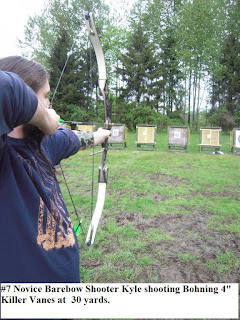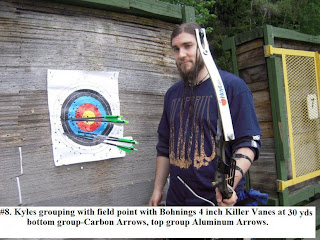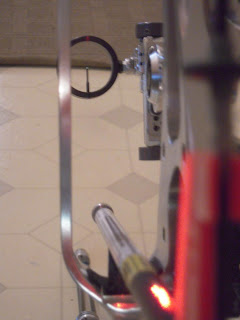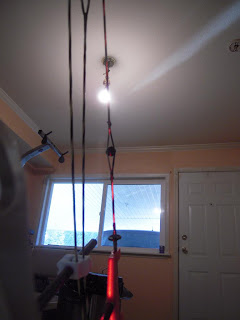By Barry O’Regan – Bohning Pro Field Staff, T.R.U. Ball Staff Shooter.
Impressive is all I can say with the 3 degree angle look and performance of the Bohning Vanes fletched using the Bohning Helix Tower Jig.
Bohning Helix Tower Jig
As the photos attest, a helical spin looks sweet with the benefit that you will soon find amazing stability and grouping when you put a helical spin on your arrows.
If physics has taught us anything when it comes to the average bow speeds today, a helical spin on an arrow offers more stability and self correcting properties in flight at various distances over a straight vane. This is especially important for Bowhunters using broadheads, FITA and 3D Shooters looking for that added edge in tournaments.
I own an assortment of Jigs, Bitz, Arizona E-Z fletch (both models) as well as both Jo-Jo Jan straight and helical jigs.
While all these are well made jigs, they do not allow for human error, when it comes to consistency from vane to vane when trying to put a helical twist on your arrows. I need a consistent vane to vane helical or straight vane profile from arrow to arrow. Bohning's Helix Tower Jig does just that!
Perfectly fletched arrows using the Bohning Helix Tower Jig
You would be hard pressed to get your Vanes on your large or small diameter carbon arrows with a perfect degree of offset on similar fletching jigs without trial and error and more effort.
Getting a perfectly aligned helical on small diameter shafts are now possible with Bohning!
The Bohning Helix Tower Jig, provides the archer with varying shaft diameter posts for pretty much every arrow available. Now can you say the competitor's fletching jig offers you the same versatility? Bohning Does!

The two photos above show a perfect 3 degree helical 1.75 Bohning X vane on a ultra skinny diameter Victory VAP!
A comparison with the Arizona E-Z fletch.
The Arizona E-Z fletch like the Bohning Helix Tower share similar qualities such as three articulated arms to install your three vanes at once and a top locking cap. The Arizona E-Z Fletch requires you to insert a nocked arrow into the receiver in order to align the shaft. With the slotted the grooves Vanes are easy to insert, feathers on the other hand can be a tight squeeze and sometimes squish or distort the feathers.
While with the Arizona E-Z fletching unit swings the arms up the shaft, you first have to pull and twist the bottom of the tower to lock the three arms in place, then put the cap on the top of the three arms to secure the three arms from shifting.
At times when using the lock and twist method, it is sometimes not as easy as it appears and trial and error gets the best results.
A comparison with the Jo-Jo Jan multifletcher.
The Jo-Jo Jan multi fletching units will only fletch one feather at a time, but you can fletch 6 single feathers to each arrow at once. The Jo-Jo Jan is comprised of a rotating nock receiver for your nock to fit into.
The Jo-Jo Jan requires you be adept at aligning the top and bottom arrow holders, with screwdriver in hand, to get your feathers centred or offset perfectly onto the shaft.
I use the Jo-Jo Jan mostly for my 5 inch Gateway or Trueflight Feathers, which seems better suited in this case over other fletching units.
Note: All these jigs with the exception of the Arizona E-Z fletch will only do one vane at a time.
What I need is a foolproof, idiot proof jig that when I put in a vane it comes out perfect and is consistent from vane to vane, arrow to arrow, with no fussing about aligning the star constellation and earth axis. Bohning did just that with their Bohning Helix Tower Jig which puts a perfect helical on all three vanes at the same time and alignment is perfect from arrow to arrow.
Below is the A to Z (actually A to O) on the how to apply a helical fletch on your arrows. This tutorial will assist archers on how to apply a perfect and consistent helical spin on their vanes or feathers using the Bohning Helix Tower Jig.
Now to begin the fletching process
First remove your nock from your arrow, then give your un-fletched arrow a quick wipe with a clean cotton cloth dipped in a tiny amount of Bohning Archery SSR Arrow Shaft Cleaner to remove any residue and contaminants.
Then place your un-nocked arrow shaft over the centre post in Bohning Helix Jig.
Note the arrows logo, make sure you align your cock fletch with the arrows logo, this is a very important step. Failure to do so may mean poor arrow grouping at longer distances.
My testing of various arrow manufacturers has shown most place their logo on or near the stiffest part of the carbon arrows spine.
PSE X-Weave have no parting line and are an interweave construction around the arrow, thus their arrows are reputed to be at an optimum spine no matter where you position your nock.
What we want to achieve is arrow spine consistency from arrow to arrow, so if you align the cock fletch with the manufacturer logo it is reported your arrows should be all spined consistently, though the label may not be the stiffest part of the spine, just a consistent spine. You can field practice later on, adjusting your nock accordingly to determine the tightest arrow groups.
A consistent spine means consistent arrow groups.
Once consistent spine alignment for your arrow is assured. In my case the arrow logo was the correct spine alignment for me, take your Bohning Fletch-Tite Platinum glue and apply it along the Bohning vane grooves.
Insert your vanes into the slots in the arms
Overview of the 3 degree slots in the Bohning Helix Jig 3 articulated arms.
Apply your Bohning Platinum Glue to your vanes,
As you fold up the fletching arms carefully; note the position of freshly glued cock vane, ensuring it is aligned perfectly to the arrow logo and press the fletching arms upwards and lightly against the arrow shaft.
Then take the red locking collar and slip it over the top of the arrow shaft and using light to moderate pressure as you slide the locking collar down towards the Bohning Helix Tower jig. Do not use too much pressure pushing down the collar to seat as it will distort the vane against the arrow shaft.
Wait 5 minutes, and lift off the Red locking collar completely, then pull away the fletching arms one by one slowly away from the arrow.
Pull out your arrow, check for the vane consistency, then put back your arrow’s nock, place the arrow nock right side up and let cure and dry for 4 hours or overnight before using. Cleaning excess glue off the fletching arms can be easily removed quickly with your fingernail or blunt popsicle stick. Try doing that with other jigs, good luck!
You now have a perfect 3 degree helical fletched Bohning Blazer Vane, perfection is also achieved even on a skinny Victory Nano (now called VAP) arrow with no vane overhang off the arrow.
Please Note
Using the Bohning Helix Tower jig will offer the same helical results from any vane up to 2.5 inches in length and will work with any make of arrow you choose.
If you use vanes longer than 2.5 inches in length, you will need the model called the Bohning Complete Tower Fletching jig, which comes with various fletching arms to accommodate each different vane length.
To be certain, with Bohning’s variety of fletching arm configurations the archer will not be disappointed with the results!
Field Test
I took my newly helical vane arrows to the range to compare grouping and accuracy against my straight vane Bohning Blazers and X-Vanes.
From 10 yards to 50 yards, both helical and straight vane arrows grouped almost identical, with the helical vane arrow getting a little tighter grouping.
I then went out to 50-55 yards (most likely the longest distance you will shoot in a 3D shoot or hunting scenario) and shot my straight vane Bohning Green vane equipped arrows, picking two random spots on the target face. This was followed by shooting my helical Bohning Red vane equipped arrows and aiming at where I placed my two previous straight vane arrows. The result was no arrow drop with the helical vanes and bang on the money slapping against my straight Blazer vane arrows.
Arrow drop with a helical vane arrows is minimal over 55 yards, with a noticeable arrow drop at distances over 55 yards when compared to straight vane arrows. Since a helical vane on an arrow may drop a tad at longer distances, I found it does offer more stability and arrow correction at any distance. All that is needed is a small sight adjustment to bring your helical vane arrows back in line at distances over 55 yards.
The two photos below show groupings with a 3 degree helical on Bohning 1.75 Vanes with skinny diameter Victory VAP arrows.
Bohning’s Vice President of Sales and Marketing, Dale Voice asked me what the results would be shooting a hunting arrow like the Victory HV 400 equipped with a Bohning Blazer with a 3 Degree Helical at 90 meters, a FITA distance!
Well as you can see the helical Blazer vane gave a nice arrow group with a 1st and 2nd rough sight dial in. One of our Burnaby Club members Phil, witnessed this first time 90 meter distance shoot and was amazed a large diameter hunting arrow equipped with helical Bohning Blazers displayed such a nice group at 90 meters. I can assure you my groups with straight vane Blazers at 90 meters would not be as tight a group.
Most FITA shooters use straight vanes or a small offset on their skinny arrows such as Easton X-10s and McKinney arrows, both which have small diameter arrow shaft, both which are not really suited to take such a radical 3 degree helical vane.
Shooting hunting arrows equipped with Bohning Blazers and a helical at 90 meters was under windy conditions during this field test. While the 90 meter arrow grouping was nice, wind definitely affected the arrow flight accuracy, but not arrow stability to group as it did. Still impressive!
Perhaps with further tuning, I could use these Helical applied Bohning Blazers in a FITA shoot just for the line cutting ability, though I surmise fellow FITA shooters may not like a Bohning Blazer equipped large diameter hunting arrow slamming into their pricey Easton X 10s or McKinneys.
Conclusion
All in all when points count, especially in 3D shoots, FITA (under 50 meters) and Bowhunting, you cannot beat a helical fletched Bohning vane, courtesy of Bohning Archery and their Bohning Helix Tower Jig.
For those who use 4-5 inch feathers exclusively, this Bohning Helix Tower Jig will not be able to handle your needs, though Bohning has a single jig for that purpose.
For those who want to do 6 arrows at a time Jo Jo Jan multi jig and similar multi clamp style jigs will most likely serve you better.
















































